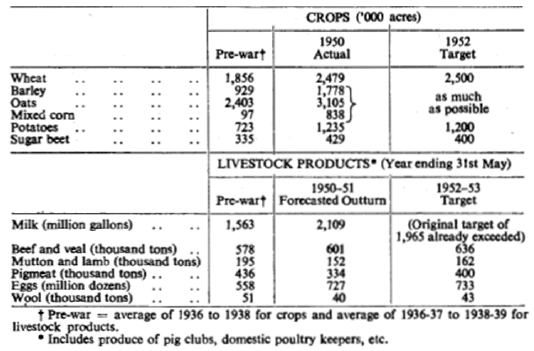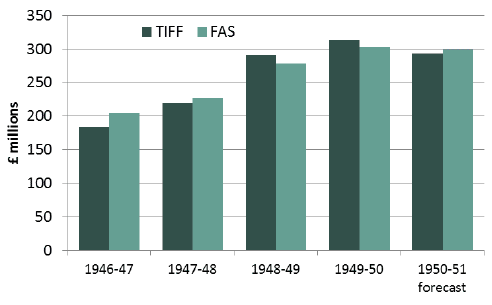Economic Report on Scottish Agriculture, 2016
Presents an overall picture of Scottish agriculture using data from the various agricultural surveys that RESAS manage.
Annex B: Price-fixing in agriculture
"The Annual Review and Fixing of Farm Prices 1951" was a report presented to Parliament by the Secretary of State for the Home Department, the Minister of Agriculture and Fisheries and the Secretary of State for Scotland, in May 1951.
The aim of the review was "promoting and maintaining…a stable and efficient agricultural industry capable of producing such part of the nation's food and other agricultural produce as in the national interest it is desirable to produce in the United Kingdom, and producing it at minimum prices consistently with proper remuneration and living conditions for farmers and workers in agriculture…", in line with the general objective of the Agriculture Act 1947.
One main instrument of achieving this at the time was the Government providing guaranteed prices and assured markets for cattle, sheep, pigs, milk, eggs, wheat, barley, oats, rye, potatoes, sugar beet and wool (and so not fruit, veg or poultry meat). As set out in the report, prices for these were determined by government analysts and the farmers unions firstly agreeing production objectives for the industry, then the necessary gross receipts required for this level of production, and hence the commodity prices needed to provide this income.
To set the scene, in 1951 oats accounted for 80 per cent of Scotland's cereals grown, there were 6.9 million sheep (a similar number to 2015), 1.6 million cattle (11 per cent fewer than 2015), 339,000 pigs (seven per cent more) and 9.9 million poultry (24 per cent fewer), and there were still more horses than tractors used in agricultural production. Scotland's population was 5.1 million, (five per cent lower than 2014). Note, however, that while the Secretary of State for Scotland and the National Farmers' Union of Scotland were involved in the discussions, planning and the resulting price-fixing was carried out at a UK level.
For 1951 the decision was taken to seek to reduce the acreage of wheat in the hope that improved yield would produce a similar tonnage. Farmers were to be asked to produce as much oats, barley and rye as possible, due to shortages of animal feed. There was an expected decline in demand for potatoes (no explanation of why), so the area was to be reduced accordingly. While it seems milk production had been increasing, encouraged by government subsidies, it was determined that this growth should be dampened, so as to maintain the current amount. There was also reference to the seasonal nature of milk production, likewise with the egg industry, with a glut in the spring and early summer and relative shortages in the autumn and winter, and so a widening of the differential guaranteed prices between the seasons was suggested as a remedy. Finally, meat production was seen as most desirable, and farmers were again encouraged to produce as much as they could.
Chart 1: Production objectives, UK

In terms of farm income data, the same two measures were considered then as now. Total Income from Farming was calculated for the industry as a whole, for each type of commodity and each input. And secondly, farm accounts were considered, to produce an average income for each type of farm, which could then be scaled up for the "national farm". Problems with both sources of data, which are described as "at an experimental stage", are recognised in the paper.
Chart 2: Aggregate Farming Net Income, UK

Other factors, for which there were no data, were then considered. Likely difficulties in labour supply, caused by the disbandment of the Women's Land Army and the Committee Labour Pools, and call-up for the army (Korean War), were expected to cause obstacles to the required increase in production, as were foreseen shortages of capital investment and fertiliser. The government was also looking to progressively reduce its post-war injection of capital investment into farming. Hugh Gaitskell's recent budget had stated that there was no money for increasing food subsidies, and so any price rises to the farmer would have to be paid for by consumers. Another factor considered was the very poor winter of 1950/51 (apparently there had been 102 days of lying snow at Dalwhinnie).
On the positive side, advances in crop varieties, crop protection and livestock breeding were noted as favourable influences, and the government also considered that farmers' "current net incomes contained a fair margin in hand which would enable farmers to… bear a proportion of the increasing costs without detriment to their capacity to reach the production estimates".
Based on the data and other information before them, the Government decided that farmers' gross receipts should be added to by the annual amount of £32 million for food products and £11.25 million for wool, a balance that seems strange nowadays where wool only accounts for 0.2 per cent of farm output.
Minimum livestock prices were then fixed, as detailed on the following page, which were then translated into specific prices for grades, seasons and, in some cases, areas, aimed at influencing seasonality, marketing and quality. The Government then assured a market for the whole output of the guaranteed price commodities, except that for sugar beet, which was fixed at the factory capacity for this product.
By 1953, the equivalent report's authors were already commenting on the "forthcoming decontrol of cereals and eggs", stating that "The Government are anxious that permanent arrangements should be brought into operation at the earliest possible date which would provide satisfactory means for implementation of [the objective of the Act] in the circumstances of a freer agricultural economy."
Table A: Crop Prices
| 1951 Harvest price announced March 1950 | Special Review increase | Revised prices for 1951 harvest | Annual Review Increase | 1952 Harvest price | ||||||
|---|---|---|---|---|---|---|---|---|---|---|
| Wheat, millable, per cwt | 28s. | 0d. | 4d. | 28s. | 4d. | 1s. | 0d. | 29s. | 0d. | |
| Barley, feeding, minimum price per cwt (i) | 21s. | 6d. | 4d. | 21s. | 10d. | 1s. | 6d. | 23s. | 0d. | |
| Oats, feeding, minimum price per cwt (ii) | 19s. | 4d. | 4d. | 19s. | 8d. | 1s. | 4d. | 20s. | 8d. | |
| Rye, minimum price per cwt | 21s. | 6d. | 4d. | 21s. | 10d. | Nil | 21s. | 6d. | ||
| Sugar Beet, per ton, average for all factories | 106s. | 2d. | 2s. | 4d. | 108s. | 6d. | 2s. | 6d. | 108s. | 8d. |
| Potatoes, standard ware potatoes, average per ton (iii) | 224s. | 0d. | 4s. | 6d. | 228s. | 6d. | 8s. | 0d. | 232s. | 0d. |
(i). The guaranteed price for barley is the minimum price for feeding barley only.
(ii). The guaranteed price for oats is the minimum price for feeding oats only.
(iii). Sub-standard ware: 15s. per ton less in 1951 and 55s. per ton less in 1952
Table B: Prices of Livestock and Livestock Products
| Estimated average | Prices increased for 1951-52 | ||
|---|---|---|---|
| prices in 1950-51 | Special Review | Annual Review | |
| Milk - average pool price plus production bonus and quality premiums - per gallon (ii) | 2s. 10 1/10d. | 1/8d. | 1½d |
| Fat cattle - steers, heifers and cow heifers - per live cwt (iii) | 106s. 8d. | 6d. | 9s. 9d. (Special, A and B grades) 9s. 3d. (C grade) |
| Fat cows - per live cwt | 65s. 11d. | 6d. | 7s. 6d. (Special and A grades) 6s. 0d. (B grade) |
| Fat bulls | 58s. 4d. | 6d. | 4s. 0d. |
| Fat sheep and lambs - per lb dressed carcase weight (iii) | 2s. 4d. | 1/6d. | ¾d. |
| Fat pigs - clean pigs in standard weight ranges - per score dead-weight (iii) | 48s. 2d. | 1 3/5d. | 5s 0d. (Pigs in quality weight ranges only, lower increases for others |
| Hen eggs - sold through packing stations, per dozen | 4s. 1d. | 1¼d | 2¼d. |
| Duck eggs | 3s. 9d. | 1¼d | (Restriction on sales and prices proposed to be removed. Guaranteed annual average price of 3s.0¼d per dozen) |
| Wool - per lb | 2s. 3d. | - | 3s. 9d. |
Notes:
(i) 1 st April, 1951 to 31 st March 1952
(ii) The average price per gallon for milk is made up as follows:- Average wholesale pool price 31.75d. Production bonus 0.70d. Quality premiums (includes attested bonus) 1.66d.
(iii) The average fat stock prices for 1950-51 include quality premiums in the case of cattle and pigs and headage payments in the case of sheep and lambs. Casualties and rejects receive price increases proportional to the increase for the appropriate classes (e.g. steers, cows, etc.). The annual review increases for pigs also include sows, boars, etc., the details for these classes being published separately.
The full report is available at www.gov.scot/Topics/Statistics/Browse/Agriculture-Fisheries/Publications/Agstats1950
A large number of historical publications are available at www.gov.scot/Topics/Statistics/Browse/Agriculture-Fisheries/Publications/histagstats
Contact
There is a problem
Thanks for your feedback